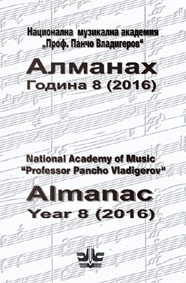Die Musik des 20. Jh.: eine Herausforderung für die Gehörbildung?
The Music of the 20th Century – a Challenge to Solfège?
Author(s): Violaine De LarminatContributor(s): Angelina Petrova (Translator)
Subject(s): Fine Arts / Performing Arts, Music
Published by: Издателство НМА „Проф. Панчо Владигеров”
Keywords: solfège; 20th century; melodies and chords in 20th century music; mode scales; microintervals and microintervalics
Summary/Abstract: 1894: “L’après-midi d’un faune”, 1912: “Pierrot lunaire”, 1913: “Le sacre du printemps”. Three dates and three works that are counted as the pickup measure of 20th century music. Since then numerous works have been created in a wide array of style and music expression: variety that seems to impede this period’s systematization. Still: is such music theory characterization impossible, or very difficult? This question stems from solfège’s pedagogy, that is often accused that is not suited for that époque. This discipline’s tradition pedagogic approaches seem passé: the usual chord and melodic constructions and changing harmonic and contrapuntal rules of the functional tonal system, existing in an established measure construction since the Renaissance, the sound of a conventional orchestra, based on string instruments, as well as the tonally limited structures of the old music, still remain an important and much needed field of the discipline solfège; however they do not longer cover the quality specifics of the 20th century. We have catalogues from olden time, describing the various usually used technical and stylistic means – that turn us into the right direction to offer a purposeful, effective and specialized training in solfège. Such summary enumeration lacks for the 20th century, because until the present, efforts were made do stress stylistic features of the particular composers, but not to seek common features in their writing techniques; thus making possible the crystallization of a common music language characteristics. It would seem improbable that the actual challenge to solfège could be determined with such an overview, as well as to consider the right direction that solfège should take. New hearing strategies could be formulated, to develop new exercises and assignments, but also to create new directions for the discipline of solfège, as well as new levels of competency in the future. This article presents musings and perspectives that have occurred by means of a long teaching experience the discipline “Solfège for composers and music directors.”1894: “L’après-midi d’un faune”, 1912: “Pierrot lunaire”, 1913: “Le sacre du printemps”. Three dates and three works that are counted as the pickup measure of 20th century music. Since then numerous works have been created in a wide array of style and music expression: variety that seems to impede this period’s systematization. Still: is such music theory characterization impossible, or very difficult? This question stems from solfège’s pedagogy, that is often accused that is not suited for that époque. This discipline’s tradition pedagogic approaches seem passé: the usual chord and melodic constructions and changing harmonic and contrapuntal rules of the functional tonal system, existing in an established measure construction since the Renaissance, the sound of a conventional orchestra, based on string instruments, as well as the tonally limited structures of the old music, still remain an important and much needed field of the discipline solfège; however they do not longer cover the quality specifics of the 20th century. We have catalogues from olden time, describing the various usually used technical and stylistic means – that turn us into the right direction to offer a purposeful, effective and specialized training in solfège. Such summary enumeration lacks for the 20th century, because until the present, efforts were made do stress stylistic features of the particular composers, but not to seek common features in their writing techniques; thus making possible the crystallization of a common music language characteristics. It would seem improbable that the actual challenge to solfège could be determined with such an overview, as well as to consider the right direction that solfège should take. New hearing strategies could be formulated, to develop new exercises and assignments, but also to create new directions for the discipline of solfège, as well as new levels of competency in the future. This article presents musings and perspectives that have occurred by means of a long teaching experience the discipline “Solfège for composers and music directors.”
Journal: Алманах - Национална музикална академия „Проф. Панчо Владигеров“
- Issue Year: 2017
- Issue No: 8
- Page Range: 19-99
- Page Count: 81
- Language: Bulgarian, German

